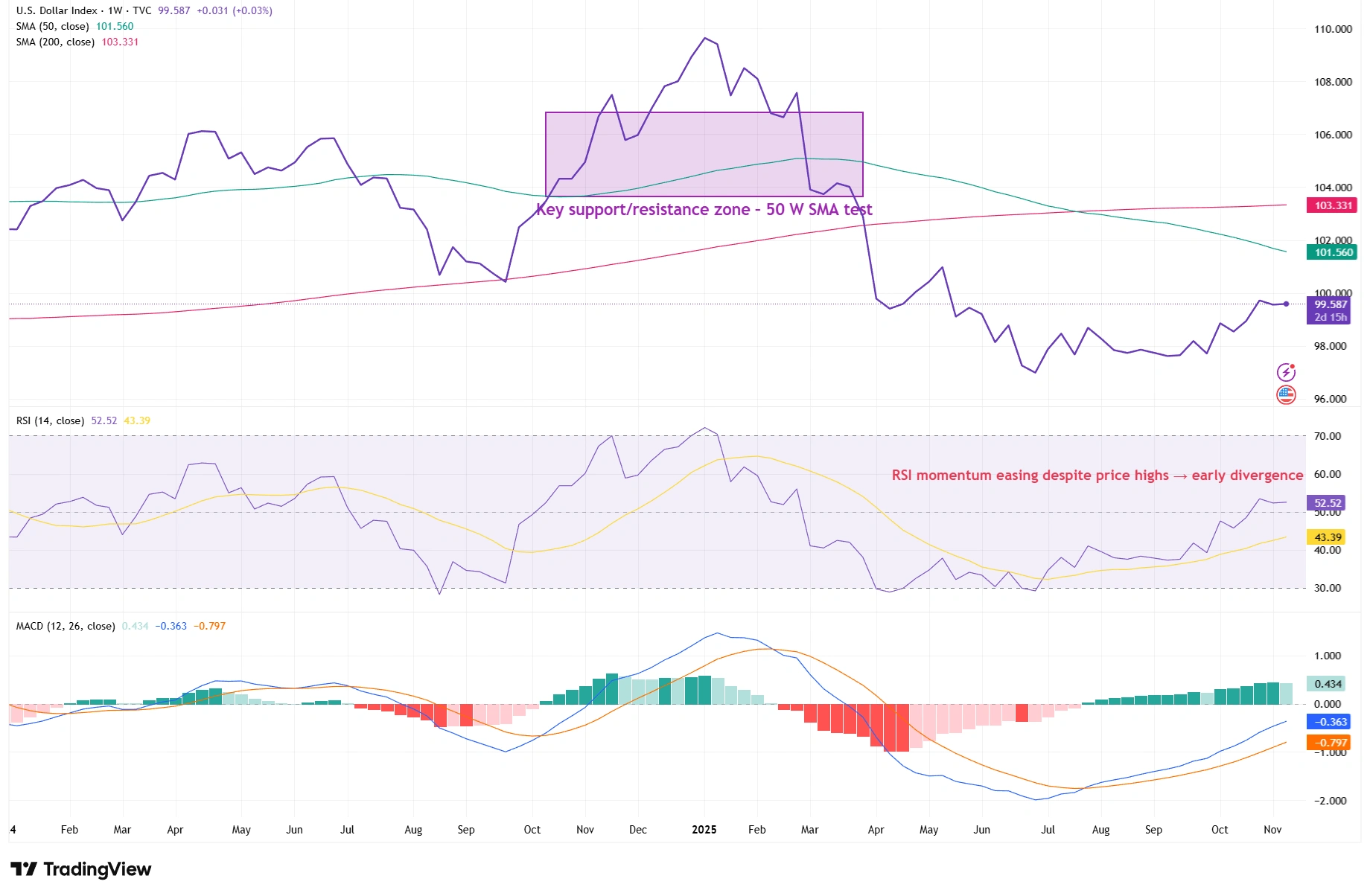The Dollar’s Turning Point: Is the DXY’s Uptrend Losing Steam?
After dominating global markets for over a year, the US dollar has quietly slipped from its recent peak. The DXY index is easing: a stronger dollar had been tightening liquidity worldwide, while a softer dollar breathes life into stocks, commodities and emerging markets (and that’s something we’ve seen this year). Traders can’t help but wonder: is the greenback finally running out of steam or is this just a pause before another push higher?
The Technical Landscape
On the daily chart, dollar bulls still boast higher highs, but the pattern looks increasingly fragile. Price action is forming a rising wedge, a bearish setup where up-sloping trendlines converge, often preceding a reversal. Momentum indicators are flashing early warnings. The 14-day RSI shows bearish divergence (price reaching new highs as RSI weakens), hinting at waning power. The MACD has flattened after its run, suggesting the rally is losing thrust.
After surging, the DXY now hovers near its 50-day moving average (testing short-term support) while volume on each new high has thinned. In other words, rallies have slowed. Analysts often call this a “pause after a strong rally,” marked by early signs of momentum fatigue. When advances weaken in volume and pace, it usually signals conviction fading before sentiment turns.
US Dollar Index (DXY) – Rising Wedge and Bearish Divergence

Source: TradingView. All indices are total return in US dollars. Past performance is not a reliable indicator of future performance. Data as of 12 November 2025.
The DXY’s long uptrend is tightening into a wedge, with RSI and MACD showing signs of exhaustion near the 50-week moving average.
The Macro Undercurrent
The technical strains align with shifting fundamentals. Fed rate-cut expectations have climbed for 2026. Goldman Sachs now pegs two 25-basis-point cuts in March and June of that year, and recent US inflation data has been cooler than feared. These trends erode the dollar’s carry advantage. Meanwhile, global risk appetite has perked up: safer government yields have steadied, and equity markets have rallied. Improved sentiment has knocked some wind out of the dollar’s sails.
Easing safe-haven demand is leading to cross-asset rotation and a moderating DXY advance. In markets, technical weakness often mirrors a narrative shift before it becomes consensus. The opposite happened in 2022-23: potent dollar strength saw the DXY rise over 8% against major currencies, punishing stocks, gold, and emerging-market assets. If the pattern is now reversing, the fallout could be just as dramatic.
The Cross-Asset Ripple
A weakening dollar sends ripples far beyond currency markets. Commodities and emerging economies usually benefit when the greenback softens because of cheaper financing, higher export prices, and stronger capital inflows. Historically, commodity prices tend to rise when the dollar retreats.
Case in point: as the DXY pulled back, gold and oil both advanced, while even bitcoin found support. Major currencies are also reflecting the shift. The euro has broken out of a multi-week downtrend, rallying as US yields slide, while sterling and other majors are quietly firming. For traders, the DXY isn’t just a currency index, it’s a global sentiment gauge. If the dollar’s grip continues to loosen, 2025 could be the year global risk assets finally catch a broad bid.
EUR/USD: Breaking Out of the Downtrend

Source: TradingView. All indices are total return in US dollars. Past performance is not a reliable indicator of future performance. Data as of 12 November 2025.
As the euro strengthens and breaks from its long-term downtrend, the dollar’s momentum fades, a mirror move that often marks the early stage of global sentiment shifts.
What to Watch / Trader’s Lens
- Bearish confirmation: A clean break below the rising wedge’s lower trendline (around the 50-day MA near 104.50) would signal a trend reversal. Look for a decisive close under that zone on stronger volume.
- Bullish invalidation: A sustained rebound above 107.50 with solid volume would imply the uptrend remains intact.
- Key reads: Watch Fed commentary and US data. A sudden surge in Treasury yields or inflation could revive dollar strength and negate the bearish case.
For now, the chart is whispering weakness, but in currency markets, even a whisper can turn into an avalanche overnight.
Closing Thoughts
Every dominant trend eventually meets its mirror. The dollar’s climb has defined this cycle, but if it is indeed starting to fade, the implications are profound. A downshift in the greenback won’t just move FX rates, it could reshape how investors view risk across equities, commodities, and beyond.